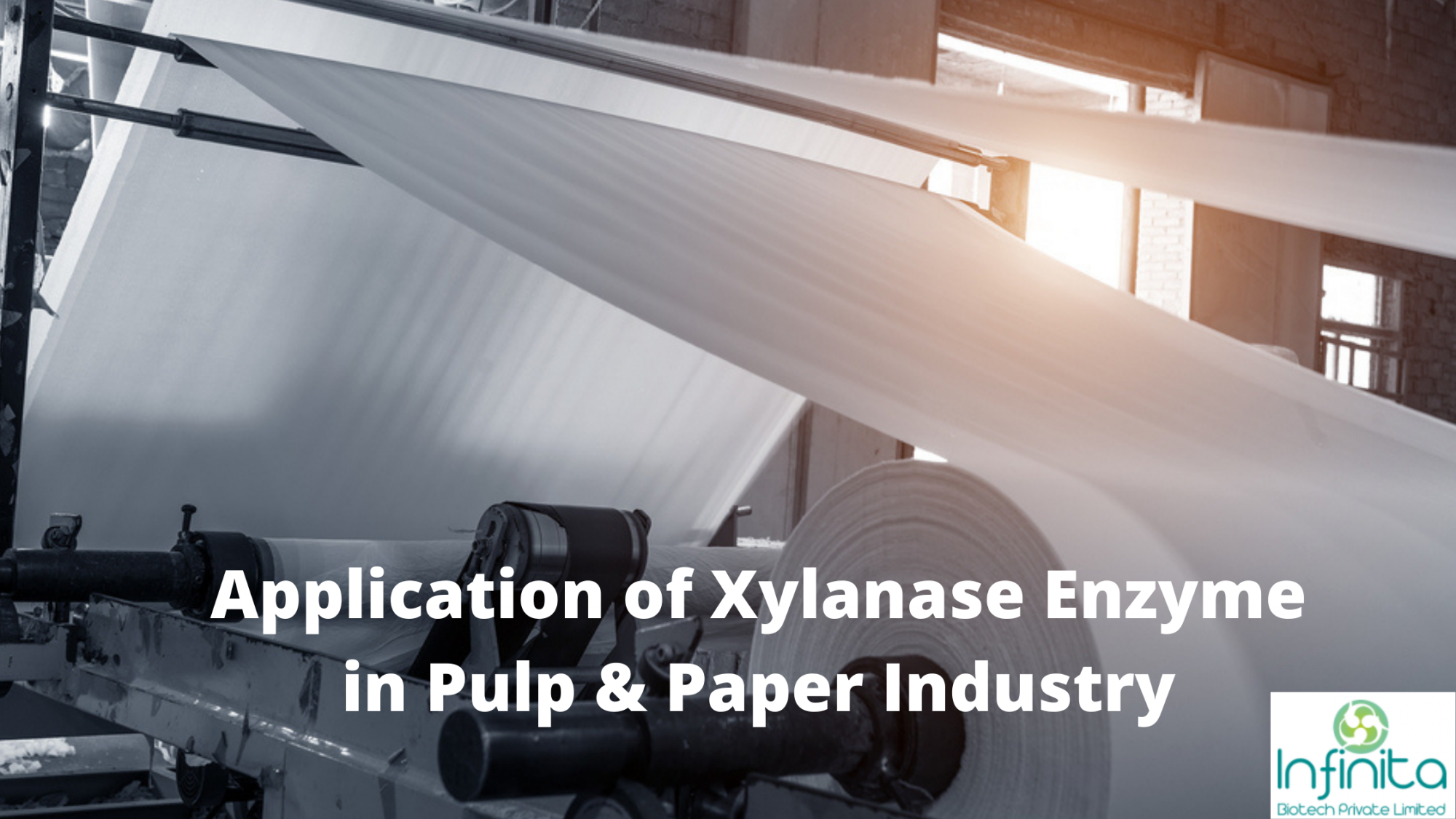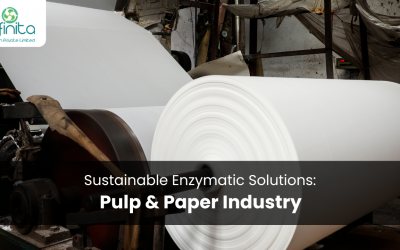
Application of Xylanase Enzyme in Pulp & Paper Industry
Application of Xylanase Enzyme in Pulp & Paper Industry
The pulp and paper industry uses chlorine for bleaching purposes. The bleaching process results in the creation of organochlorine compounds. These are generated by the reactions between chlorine and residual lignin present in wood fibers. Many of these compounds harm the environment as they are mutagenic, toxic, persistent, and bioaccumulating. The discharge of wastewater containing these compounds into water bodies results in the elimination of aquatic species, pollution of potable water, and accumulation of toxins in the body of fishes. Due to these factors, the industry has to face certain limits and restrictions on the discharge of these compounds. To solve this problem, xylanase enzymes can be used in the pulp bleaching process which works both for woody pulps and non-woody pulps made from fibers like jute, wheat straw, and rice straw. This process is known as ‘bio-bleaching’ helps prevent the production of organochlorine compounds.
Xylanase Enzyme Application
The application of xylanase for bleaching has resulted in the improvement of certain aspects of the pulp and paper industry and processes. These include reduced costs, better quality products, and less environmental pollution. This is achieved by using xylanase instead of chlorine-based bleaching in the bleaching process which leads to the creation of dangerous absorbable organic halides (AOX). Using enzymes for pretreatment of hardwood kraft pulp has reduced bleaching costs by nearly 89% and resulted in increased brightness of bleached pulps. Xylanase treatment is done by substituting chlorine as a bleaching chemical with hydrogen peroxide and ozone.
The application of xylanase is also called ‘Pre-bleaching’ or ‘Bleach boosting’. Xylanase increases the effects of bleaching compounds by breaking the xylan network, which helps remove trapped lignin from the pulp instead of directly removing lignin or attacking lignin-based chromophores.
Bleaching using xylanase necessitates meticulous control of factors such as pH, temperature, and retention time. The kind of raw material, the pulping process, the brown stock washing, and the bleaching sequence all have a significant impact on the enzyme activity.
How Xylanase Works on Pulp and Paper
Due to kraft pulping, short xylan chains deposit onto fiber surfaces. Xylan physically traps the lignin, which results in fiber swelling. These xylans act as a barrier and prevent the penetration of bleaching agents. This leads to increased use of chlorine dioxide (ClO2) during the first bleaching stage.
Xylanase enzymes break the link between lignin and hemi-cellulose and thus remove xylan. During the next stage of the bleaching process, lignin is removed easily as its links with hemi-cellulose have been broken down. Reduction in xylan concentration increases the fiber permeability, thus improving its bleachability.
Xylanase Enzyme Production
Xylanase enzymes produced through fungal or bacterial strains commercially are readily available for use in bleaching pulp with higher brightness and lower kappa number. Using these enzymes also reduces brightness reversion and improves the physical strength of products. Xylanase-producing microorganisms include both bacterial and fungal strains, but the former has more advantages over the latter as bacterial strains produce more alkaline-thermostable xylanase than fungal ones. The optimum pH and temperature of bacterial xylanases are higher than that of fungal xylanases, which are better suited for industrial applications, including pulp and paper industries. Bacillus strains produce high levels of extracellular cellulase-free xylanases that are stable at both high temperatures and alkaline pH. Fungal xylanases are not used in the direct treatment of brown stock pulp as their optimal activity occurs in a pH range that is too low for the above treatment. The optimal pH range should allow the brown stock to be treated without acidification. Bacterial xylanases fulfill all the requirements and are used in the bleaching of pulp.
Conclusion
The bleaching process requires high pH and temperature. Many xylanase-producing microorganisms are extremophiles which means they remain highly active and stable at high pH and temperatures. Xylanases derived from these extremophiles stay active under these conditions and are optimized for use in the pre-bleaching process. They reduce the consumption of toxic bleaching chemicals, lower costs, and are environmentally friendly.
XYLANASE
It can be applied for bleaching.

Overcome Pre-
Bleaching

Reduce Bleaching
Cost

Better Pulp
Properties
Related Articles
Unlocking Innovation: Exploring the Latest Advances in Pulp and Paper Enzyme Technology
The pulp and paper industry is constantly searching for innovative solutions to improve efficiency and reduce environmental impact. One area that holds great promise is enzyme technology. Enzymes, as natural catalysts, have the ability to enhance various processes in...
Sustainable Enzymatic Solutions in Pulp & Paper Industry
Introduction The pulp and paper industry, a vital sector of the global economy, is also among the most environmentally impactful. This industry is not only a significant water consumer but also a major contributor to water pollution. The introduction of enzymatic...

Application of Xylanase Enzyme in Pulp & Paper Industry
Application of Xylanase Enzyme in Pulp & Paper Industry
The pulp and paper industry uses chlorine for bleaching purposes. The bleaching process results in the creation of organochlorine compounds. These are generated by the reactions between chlorine and residual lignin present in wood fibers. Many of these compounds harm the environment as they are mutagenic, toxic, persistent, and bioaccumulating. The discharge of wastewater containing these compounds into water bodies results in the elimination of aquatic species, pollution of potable water, and accumulation of toxins in the body of fishes. Due to these factors, the industry has to face certain limits and restrictions on the discharge of these compounds. To solve this problem, xylanase enzymes can be used in the pulp bleaching process which works both for woody pulps and non-woody pulps made from fibers like jute, wheat straw, and rice straw. This process is known as ‘bio-bleaching’ helps prevent the production of organochlorine compounds.
Xylanase Enzyme Application
The application of xylanase for bleaching has resulted in the improvement of certain aspects of the pulp and paper industry and processes. These include reduced costs, better quality products, and less environmental pollution. This is achieved by using xylanase instead of chlorine-based bleaching in the bleaching process which leads to the creation of dangerous adsorbable organic halides (AOX). Using enzymes for pretreatment of hardwood kraft pulp has reduced bleaching costs by nearly 89% and resulted in increased brightness of bleached pulps. Xylanase treatment is done by substituting chlorine as a bleaching chemical with hydrogen peroxide and ozone.
The application of xylanase is also called ‘Pre-bleaching’ or
‘Bleach boosting’. Xylanase increases the effects of bleaching compounds by breaking the xylan network, which helps remove trapped lignin from the pulp instead of directly removing lignin or attacking lignin-based chromophores.
Bleaching using xylanase necessitates meticulous control of factors such as pH, temperature, and retention time. The kind of raw material, the pulping process, the brown stock washing, and the bleaching sequence all have a significant impact on the enzyme activity.
How Xylanase Works on Pulp and Paper
Due to kraft pulping, short xylan chains deposit onto fiber surfaces. Xylan physically traps the lignin, which results in fiber swelling. These xylans act as a barrier and prevent the penetration of bleaching agents. This leads to increased use of chlorine dioxide (ClO2) during the first bleaching stage.
Xylanase enzymes break the link between lignin and hemi-cellulose and thus remove xylan. During the next stage of the bleaching process, lignin is removed easily as its links with hemi-cellulose have been broken down. Reduction in xylan concentration increases the fiber permeability, thus improving its bleachability.
Xylanase Enzyme Production
Xylanase enzymes produced through fungal or bacterial strains commercially are readily available for use in bleaching pulp with higher brightness and lower kappa number. Using these enzymes also reduces brightness reversion and improves the physical strength of products. Xylanase-producing microorganisms include both bacterial and fungal strains, but the former has more advantages over the latter as bacterial strains produce more alkaline-thermostable xylanase than fungal ones. The optimum pH and temperature of bacterial xylanases are higher than that of fungal xylanases, which are better suited for industrial applications, including pulp and paper industries. Bacillus strains produce high levels of extracellular cellulase-free xylanases that are stable at both high temperatures and alkaline pH. Fungal xylanases are not used in the direct treatment of brown stock pulp as their optimal activity occurs in a pH range that is too low for the above treatment. The optimal pH range should allow the brown stock to be treated without acidification. Bacterial xylanases fulfill all the requirements and are used in the bleaching of pulp.
Conclusion
The bleaching process requires high pH and temperature. Many xylanase-producing microorganisms are extremophiles which means they remain highly active and stable at high pH and temperatures. Xylanases derived from these extremophiles stay active under these conditions and are optimized for use in the pre-bleaching process. They reduce the consumption of toxic bleaching chemicals, lower costs, and are environmentally friendly.
0 Comments
Submit a Comment
You must be logged in to post a comment.
XYLANASE
It can be applied for bleaching.

Overcome Pre- Bleaching

Reduce Bleaching Cost

Better Pulp Properties
Unlocking Innovation: Exploring the Latest Advances in Pulp and Paper Enzyme Technology
The pulp and paper industry is constantly searching for innovative solutions to improve efficiency and reduce environmental impact. One area that holds great promise is enzyme technology. Enzymes, as natural catalysts, have the ability to enhance various processes in...
Sustainable Enzymatic Solutions in Pulp & Paper Industry
Introduction The pulp and paper industry, a vital sector of the global economy, is also among the most environmentally impactful. This industry is not only a significant water consumer but also a major contributor to water pollution. The introduction of enzymatic...
Applications of Enzymes in Paper and Pulp Industries
Introduction to Enzymes Enzymes are biological molecules that play a vital role in various metabolic processes in living organisms. They are proteins that act as catalysts, speeding up chemical reactions without being consumed in the process. Enzymes are highly...




0 Comments